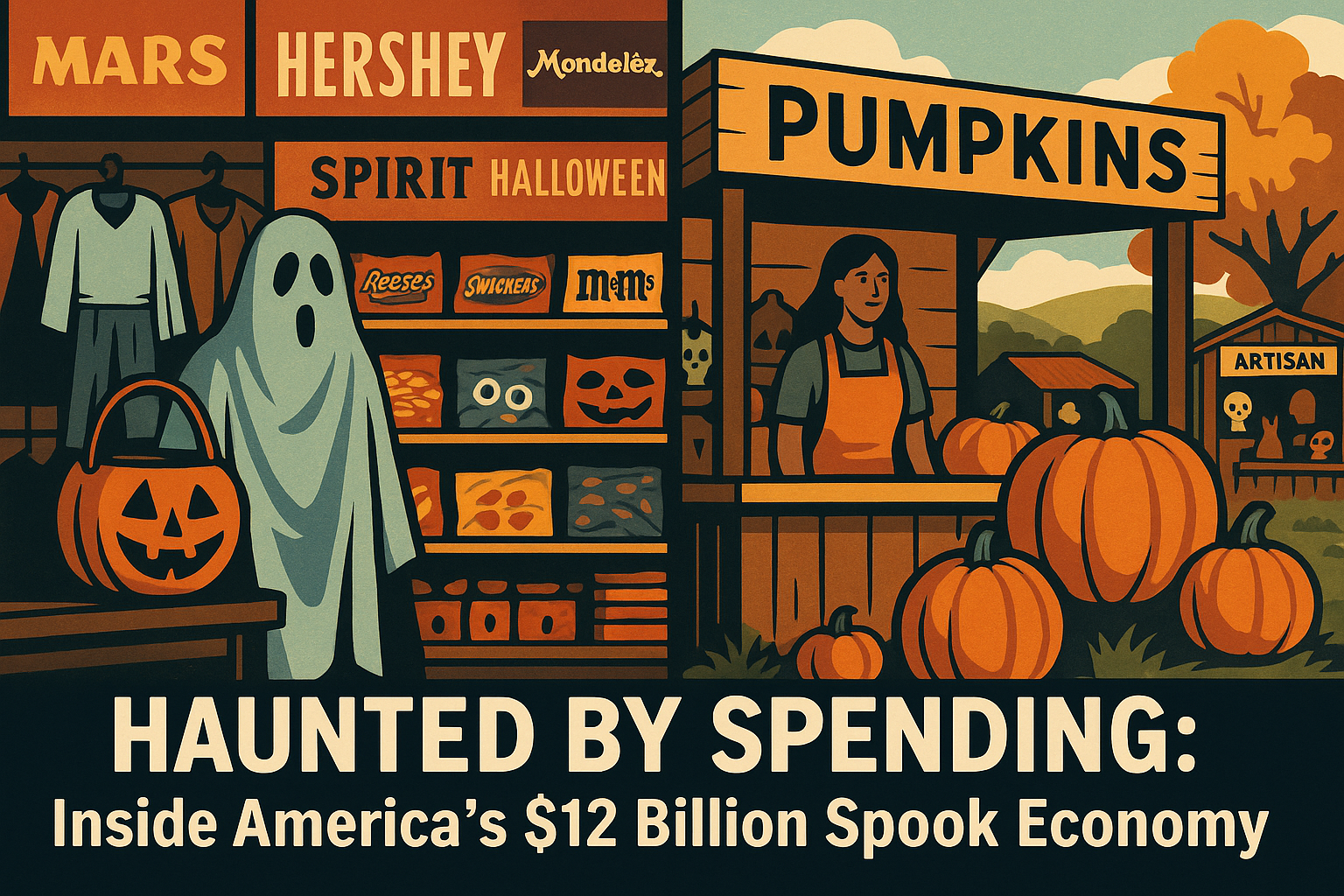Every October, Americans open their wallets for what’s become one of the year’s most profitable — and most revealing — retail events. From candy aisles to costume racks, Halloween is now a $12 billion industry, driven by corporate giants, clever marketing, and a cultural obsession with celebration and consumption. But who’s really cashing in on the holiday of fright — and at what cost?
The Candy Cartel: How a Few Companies Own the Sweetest Season
When you fill your trick-or-treat bowl, chances are most of those sweets come from just a handful of companies. Mars, Hershey, and Mondelez dominate Halloween candy sales, accounting for nearly 80% of the U.S. confectionery market. Their control over distribution, shelf space, and marketing ensures their treats remain synonymous with Halloween — from Reese’s and Snickers to M&M’s and Kit Kats.
Limited-edition flavors and spooky packaging play a key role. Seasonal exclusives — like pumpkin spice chocolate or “ghoulish green” candy bars — create artificial scarcity and drive impulse buys. It’s a strategy that works: seasonal candy sales now account for nearly a quarter of annual revenue for major confectioners.
Costume Kingdom: Fast Fashion Meets Fear
On the costume side, Spirit Halloween, Party City, and online retailers like Amazon and Shein dominate. Spirit Halloween alone operates more than 1,500 pop-up stores each fall, a model so effective it’s become part of the season’s lore.
But behind the masks lies a fast-fashion problem. Most mass-market costumes are made from cheap synthetic materials, often overseas, and designed for single use. As trends shift rapidly — from “Barbenheimer” duos to viral TikTok memes — consumers are encouraged to buy new costumes each year, fueling waste and unsustainable consumption patterns.
The Psychology of “Spooky Spending”
Retailers have turned Halloween into a masterclass in consumer psychology. Through limited runs, themed collections, and heavy social media marketing, they’ve cultivated a sense of FOMO — the fear of missing out.
This strategy drives household spending upward each year. In 2024, the average U.S. household spent roughly $110 on Halloween, up from $86 just five years prior. Decorations now rival candy and costumes in sales, as Americans turn their homes into haunted attractions. The social pressure to “go big” — especially among families and content creators — has made moderation almost taboo.
Inflation and the Post-Pandemic Shift
Economic uncertainty and rising prices haven’t scared consumers away — but they’ve changed how we celebrate. Inflation has pushed candy prices up nearly 20% in two years, forcing families to scale back or shop earlier for deals. Meanwhile, post-pandemic trends have driven a shift toward experience-based spending — from haunted houses to pumpkin patches — where consumers seek community and nostalgia after years of isolation.
This has been a small win for local businesses: pumpkin farms, craft markets, and small-batch candy makers have seen renewed interest as shoppers look for more authentic, sustainable ways to celebrate.
Local Spirits: Small Businesses Fight Back
Independent artisans and local retailers are finding creative ways to compete. Handmade costume makers on Etsy, small chocolatiers, and family-run décor shops have leaned into personalization, quality, and eco-friendly practices to stand apart from big-box uniformity.
Some towns have even revitalized community festivals and farmer’s markets to keep spending local — proof that Halloween doesn’t have to be dominated by corporate giants.
Haunted by Consumerism — But Not Doomed to It
Halloween’s evolution from door-to-door candy hunt to multi-billion-dollar spending spree mirrors the broader consumer culture in America. What started as a night of imagination has become an industry of indulgence — but it doesn’t have to stay that way.
Whether by supporting local makers, reusing costumes, or choosing sustainable décor, consumers have the power to reshape the season into something more meaningful — and a little less haunted by excess.
Sources
- NRF Consumer Survey Finds Halloween Spending to Reach Record $13.1 Billion — National Retail Federation (2024)
- Halloween Spending To Reach $11.6 Billion During Spooky Season 2024 — RetailWire (2024)
- Shoppers Spooked About Halloween Spending 2024 — The Robin Report (2024)
- Major Halloween Season Trends and Statistics for 2024 — SimpleGlobal (2024)
- Halloween: The Economic Impact of Halloween — Ready Signal (2024)

